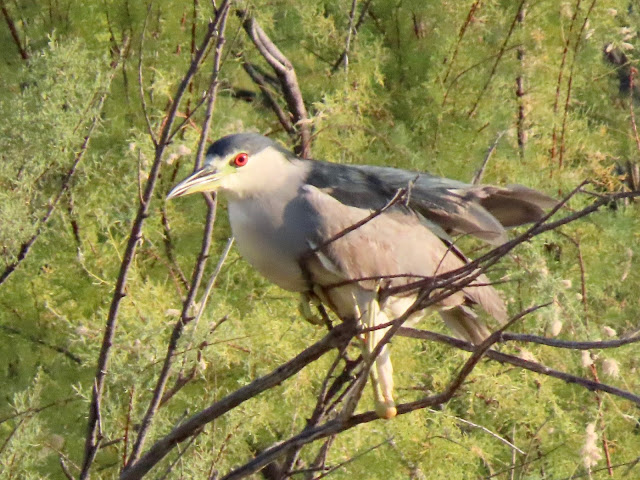Monday, October 19, 2020
Driving into the dead-end Goldfield Recreation Area, accessed north of the 4-way stop sign at Bush Highway where the Salt River Tubing warehouse sits on the NW corner of Bush Highway and Usery Pass Road, I often feel like I'm wandering into a wonderland. On the west side of the blacktop road, the open field contains a virtual "forest" of chain-fruit cholla, a leggy-type cactus full of spines that stands tall with limbs laden with fruit, still green.
One other car is already in the large parking lot above the Salt River below, This site is the final "take out" location for Tubers coming down the Salt. They must haul their tubes up the hill so we have benefited in a way by a new concrete path built for them, I assume, that now takes us quite easily down to the river-rock beach. Our first bird, SAY'S PHOEBE, was in the parking lot at 6:20.
Down the concrete path, we picked up several other desert species, including a male NORTHERN CARDINAL and a distant COOPER'S HAWK.
A GREAT BLUE HERON and GREAT EGRET appeared to be squawking at one another but we would see them loosely together from time to time farther along upstream.
Although most PHAINOPEPLA have migrated out, one couple remained. This desert species moves northward to coastal and central California and other states in that general area, as well as SE Arizona and SW New Mexico.
Lois and I took our time covering the tamarisk "islands" on the beach, one on each side. HOUSE FINCH and YELLOW-RUMPED WARB LER were abundant.
Although we checked the many YRWA we would continue to see, neither of us came up with the Magnolia Warbler that Tommy D. had seen a few days previously.
Farther east along the Salt, a GREAT EGRET on the opposite shore provided a very nice photo op through some bushes that fortunately did not infringe on the picture.
When we reached the sandstone cliffs, we scanned for PEREGRINE FALCON. Each of us found one! My sighting appeared to have it in a "time out" situation--looking into a crevice/cave opening on the east side. Lois's was out in the open about a third of the way down the cliff. Photo revealed the "time out" Peregrine was actually looking directly at us. It may have been eating something. The other was quite distant from where I stood at the time. Both of these are of the Pacific subspecies that have the more "helmeted" head as opposed to two whisker stripes beneath its eye and nape area of the Tundra species.
This PEFA took off and returned with a meal (bird) within ten minutes, so I tried to really zoom in on it after moving closer.
At 52°F at the start of the day, we managed to get in a good three plus hours of birding before the heat started to build. Many birds were not photographed, of course, but these were all special.
View this checklist online at https://ebird.org/checklist/S75097777











No comments:
Post a Comment